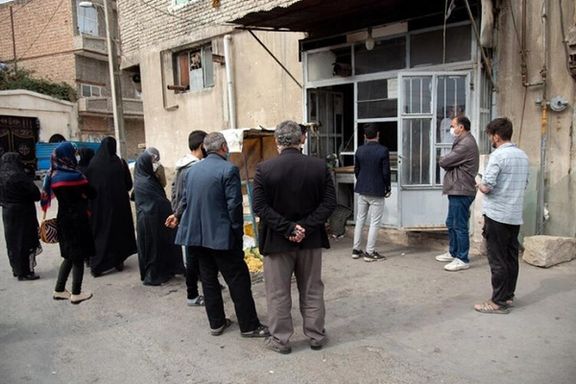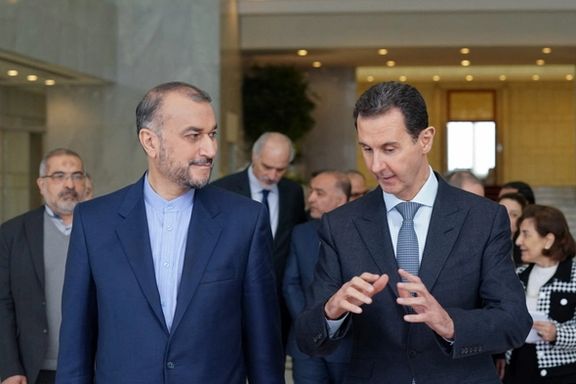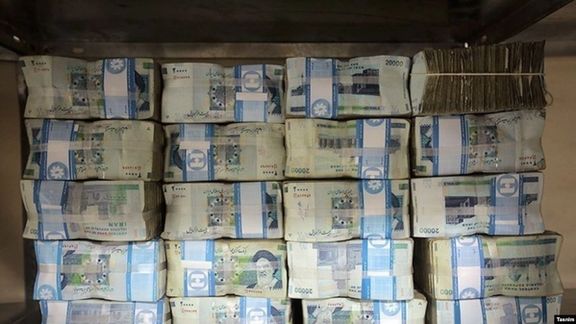Removing IRGC From US Terror List 'Dangerous Capitulation'

Three former senior Trump administration officials say removing Iran’s IRGC from the US list of foreign terrorist organizations (FTO) is “a dangerous capitulation".

Three former senior Trump administration officials say removing Iran’s IRGC from the US list of foreign terrorist organizations (FTO) is “a dangerous capitulation".
In a joint statement exclusively shared with Axios on Tuesday, former Secretary of State Mike Pompeo, Director of National Intelligence John Ratcliffe, and national security advisor Robert C. O'Brien said the move would be “a denial of the basic reality that the IRGC's core mission is to spread terror".
Quoting the US Intelligence Community Annual Threat Assessment issued last month, they reiterated that Iran is a threat to US persons directly and via proxy attacks and "previously attempted to conduct lethal operations in the United States."
“These assessments, combined with the IRGC's lengthy history of killing hundreds of Americans…make it clear: The IRGC is a terrorist organization and should remain labeled as such," they said.
“The pursuit of an ill-conceived ‘deal’ should not compel American leaders to acquiesce to the demands of a terrorist regime to deny the truth. American lives are at stake, and this is a time to project strength, not weakness."
Republican lawmakers are raising objections to removing the IRGC from the US terror list. In their latest effort, 87 representatives wrote a letter to Secretary of State Antony Blinken, urging him not to remove the IRGC from the list, saying the IRGC "is one of the most dangerous terrorist groups in the world today.

Prolongation of the Ukraine war may affect Iran's supplies of wheat, corn, vegetable oil, livestock feed, and fertilizer ingredients, pushing up prices.
Iran imports sunflower oil, wheat, corn, barley, and soybeans as well soybean meal for animal feed from Russia and Ukraine.
The volume of Iran's imports from Russia is much higher than from Ukraine. Iran's imports from Russia totaled around $1.8 billion in the first ten months of the previous Iranian calendar year which began on March 21, 2021, whereas during the same period it imported only around $162 million from Ukraine.
Nour News, which is affiliated with the secretary of Iran's Supreme National Security Council (SNSC), Ali Shamkhani, said last week that Iran’s agriculture minister, Javad Sadatinejad, signed an agreement during a recent visit to Russia to import 20 million tons of basic goods, including vegetable oil, wheat, barley and corn.
The report said the deal is to address concerns about shortages of basic goods and livestock feed in the coming months but did not mention the monetary value of the deal.
According to the US Department of Agriculture, Russia and Ukraine together account for a third of the world’s wheat exports, a fifth of its corn trade and almost 80 per cent of sunflower oil production. All three items are among Iran's imports of major essential goods.

Russia has announced additional restrictions on grain exports to ensure its own food security and to protect the domestic market.
Iran's production of wheat is likely to be around 30 percent less this year due to expected lower rainfall. According to the chairman of Federation of Iranian Food Associations, Mohammadreza Mortazavi, Iran needs to import around 3.5 million metric tons of wheat by early March. Mortazavi said importing wheat would not be a problem, but the cost will be higher.
The burden of higher costs of wheat imports will fall on the already cash-squeezed government of President Ebrahim Raisi. Earlier in March the parliament scrapped $15 billions of subsidies for imports of all essential goods except wheat, to keep the price of bread, a main staple for Iranians, steady at bakeries.
Iran’s Feed and Grain Importers Union has recently announced that the Russian invasion can also cause problems in the imports of livestock feed and grain because companies cannot keep their deliveries due to logjams in supply chains.
Soybean meal, barley and corn are imported from Russia and other countries mainly for livestock and chicken feed. Iran annually imports around 8 million metric tons of corn, 4.2 million metric tons of soybean meal, and 400,000 metric tons of barley for animal feed. Any shortages or higher prices can push up the price of meat.
The chairman of Iran-Brazil Chamber of Commerce, Fakhreddin Amerian, last month said 60 percent of Iran's corn imports originated in Brazil and the rest came from Ukraine and Russia. Amerian said a shortage of corn was not likely as more could be imported from Brazil and other sources.
On March 4 Russia’s trade and industry ministry recommended the country’s fertilizer producers temporarily halt exports, which may increase the already sky-high fertilizer prices.
Although Iran produces most of its fertilizer domestically, it imports the ingredients from various countries such as China, India, and Turkey. Higher fertilizer prices could also hugely affect the prices of rice, fruits and vegetables in Iran. Fertilizers account for around 70 percent of the production cost of rice, the most important staple food after bread in Iran.

Iran’s foreign minister visited Syria Wednesday to discuss the latest regional developments and reportedly the Russian invasion of Ukraine.
Heading a delegation, Hossein Amir-Abdollahian arrived in Damascus and was received by his Syrian counterpart Faisal Mekdad.
During a press conference, Amir-Abdollahian said that the Islamic Republic and world powers are closer than ever to reviving the 2015 nuclear deal.
He also said Tehran welcomes new talks between Syria and certain Arab countries, referring to President Bashar Assad’s visit to the United Arab Emirates last week, his first to an Arab country since the Syria war broke out.
Amir-Abdollahian said relations between Iran and Syria are in their best state, and called for more economic and trade cooperation.
Highlighting Iran’s close alliance with Syria, he said, “We are in the same trench, and we support Syria’s leadership, government and people.”
Mekdad told reporters at Damascus airport that among the issues on the agenda of his visit was the situation in Ukraine.
“We will discuss the huge developments today after Russia’s military operation in Ukraine. We will discuss what is behind that and we will discuss our mutual stances toward these developments”, Mekdad said.
Russia is recruiting fighters in Syria to fight in Ukraine, a move that can bring Iran-backed fighters into the war in Europe.
There are a myriad of groups fighting in Syria, including locals fighting for Iran and Bashar al-Assad’s forces, the Lebanese Hezbollah, Afghan and Iraqi fighters recruited and paid by Iran, and Jihadist groups opposed to Iran and Russia.

Israel should forsake “mischief” against Iran or face “revenge,” Hossein Salami, commander of Iran’s Revolutionary Guards told a memorial gathering Wednesday.
“We do not just hold funeral services for our martyrs - we also take revenge,” Salami told a memorial service for a veteran IRGC officer, Mohammad-Hassan Kusehchi, a Dezful native, who died of illness in March 2021. “These are real and serious messages.”
Major-General Salami described the new century, in the Iranian calendar, as a period of decline for the West: “The end of America and western civilization began many years ago. In addition, the revolutionary movement has continued and accelerated in recent years.”
While Israeli attacks go back to killing nuclear scientists from 2010 to 2020, and include June 2021’s attack on a nuclear facility at Karaj, there has been a recent escalation. In February, an Israeli aerial strike reportedly destroyed hundreds of drones at an airbase in Kermanshah province, and March 7 an Israeli airstrike near Damascus killed two Iranian officers in the latest of hundreds of Israeli airstrikes on Iranian forces in Syria since 2017.
The apparent response was Tehran's recent missile attack on Iraq’s Erbil, where Iran fired 12 ballistic missiles saying it targeted an Israeli secret base. Some Iran-backed sources said the Erbil attack killed several people but according to Iraqi officials no one was killed.

Iran’s annual inflation rate topped 40 percent in the past 12 months, the highest since 1996 when it reached 50 percent, according to Iran Statistical Center.
The figures show food prices rising much faster than the general inflation rate, reaching 51.5 percent from March 21, 2021, to March 20, 2022 – the period covering the Iranian calendar year 1400 which ended on Sunday.
In recent months, official reports were saying that food prices were rising by more than 60 percent, but Statistical Center, a government entity put the final annual report just above 50 percent. Government officials had also warned that poverty was rising and many middle-class families’ purchasing power dropped to the “poverty line.”
Labor unions have insisted that a family of 3.3 persons needs a monthly income of around $450 to afford basic necessities and avoid being categorized as ‘poor’, but average salaries for wage earners were between $100-150 throughout the year. Recently, government and labor representatives agreed to raise the minimum salary that most workers receive, to a little over $200 a month, which is still well below the $450 cited as the minimum need of a small family.
Private sector businessmen, however, have warned that the nearly 45-percent rise in the minimum wage will simply make inflation worse in the absence of strong economic growth.
The Iranian Labour News Agency ILNA published an interview with a member of Iran’s Chamber of Commerce, Khosrow Forughan on Tuesday, who said the inflation rate is bound to continue or get worse. The government has eliminated subsidies for food and animal feed and has raised natural gas prices for some customers, he said. He also cited a large government budget deficit as more reason for inflation to remain high.
The average economic growth rate in the past decade has been zero, affected by international and United States sanctions. But growth has been weak throughout the 43-year history of the Islamic Republic averaging about 2.5 percent, while developing countries need much higher growth to expand their economies. Still, what was achieved was mainly due to crude oil exports.
Consecutive governments have resorted to printing money to deal with sanctions and slow growth, expanding liquidity by eightfold since 2013. This is the immediate cause of high inflation.
Gholam-Hassan Netaj, a banking expert told Alef news website on Wednesday that existing high liquidity is beyond the tolerance level of the economy, leading to inflation, and creating a vicious circle of printing more money. Banks are unable to collect loans from commercial customers and they turn to the Central Bank of Iran (CBI) to borrow more money. The government also forces banks, mostly owned by state entities, to provide financing to quasi-state inefficient companies, forcing CBI to print money.
Netaj also underlined that a policy of forcing banks to provide loans for increasing industrial production will backfire because it would add to liquidity. Iran’s Supreme Leader Ali Khamenei has been urging banks to target their loans to encourage production. Netaj said that as long as the country faces high liquidity, targeted loans will not be effective.
Although Iran’s parliament is politically aligned with the presidential administration of Ebrahim Raisi, it has strongly signaled its unhappiness with several ministers. Lawmakers who were elected two years ago in a low-turnout election have to face constituents and have no answers for high inflation.
A senior member of parliament, Hossein-Ali Haji-Daligani was quoted by Etemad Online website on Wednesday as saying, “When people meet us and ask why the price of rice has doubled, we have no answers.”

More Republican lawmakers have raised objections to removing Iran’s Revolutionary Guards (IRGC) from the US list of foreign terrorist organizations (FTO).
Representative Scott Franklin – who spearheaded a letter expressing opposition to the Biden administration’s possible move – reiterated on Tuesday that the IRGC is a chief sponsor of terrorism in the world today.
In the letter, Franklin and 86 of his colleagues urged Secretary of State Antony Blinken not to remove the IRGC from the list, saying the IRGC "is one of the most dangerous terrorist groups in the world today. Through its sponsorship of terrorism, the IRGC is responsible for the deaths of countless innocent people and at least 600 US troops during the occupation of Iraq”.
They said they are deeply concerned about reports that the administration intends to remove the IRGC terrorist designation “within the confines of a new Iran Nuclear Deal”, adding “We are united in strong opposition to any move to legitimize the IRGC’s reckless, destabilizing, and anti-Semitic actions throughout the Middle East”.
Israel’s prime minister and foreign minister have called on Washington to keep IRGC on the list, saying the IRGC is "a terrorist organization that has murdered thousands of people, including Americans”.
Iranian officials have been publicly raising the issue since at least November, saying a ‘good deal’ would mean lifting sanctions on the Revolutionary Guard.
Such a step would reverse former President Donald Trump's 2019 blacklisting of the group, the first time the US had formally labeled part of another sovereign government as a terrorist group.